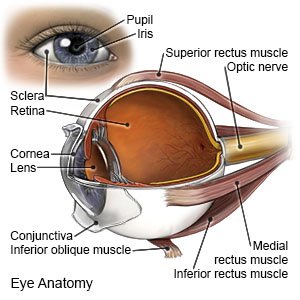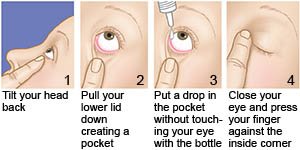Subconjunctival Hemorrhage
Medically reviewed by Drugs.com. Last updated on Aug 4, 2025.
What is a subconjunctival hemorrhage?
A subconjunctival hemorrhage is when one or more spots of blood appear on the white of your eye. The conjunctiva is the thin membrane (tissue) that covers the white of your eye. It helps protect your eye and keep it moist. The conjunctiva has many tiny blood vessels. When these break, blood appears on the white of your eye.
 |
What causes a subconjunctival hemorrhage?
The subconjunctival hemorrhage may appear on its own. The following are also common causes:
- Hard coughs or sneezes, or vomiting
- Strain, such as when you lift a heavy object or have a bowel movement
- An accident or injury to the eye
- Rubbing your eye roughly
- Wearing contact lenses
What other signs or symptoms might I have?
There are usually no other signs or symptoms. You may have mild irritation. A subconjunctival hemorrhage does not affect your vision.
How is a subconjunctival hemorrhage diagnosed?
Your healthcare provider will examine your eye and check your vision. You may need other tests to check for an underlying medical condition.
How is a subconjunctival hemorrhage treated?
The blood spot usually goes away on its own without treatment. This may take a few days or up to 3 weeks depending on how large the spot is. Artificial tears may help decrease mild irritation and keep your eye moist. Use the drops as directed.
 |
Treatment options
The following list of medications are related to or used in the treatment of this condition.
How can I prevent another subconjunctival hemorrhage?
- Use protective eyewear for all sports, activities, or work if you are at risk for an eye injury.
- Keep your contact lenses clean and be careful when you put them in or remove them.
Related medications
When should I call my doctor?
- You have eye pain or sensitivity to light.
- Your vision changes.
- You have white or yellow discharge from your eye.
- The redness in your eye has not gone away after 3 weeks.
- You have another subconjunctival hemorrhage.
- You have subconjunctival hemorrhages in both eyes.
- You have questions or concerns about your condition or care.
Care Agreement
You have the right to help plan your care. Learn about your health condition and how it may be treated. Discuss treatment options with your healthcare providers to decide what care you want to receive. You always have the right to refuse treatment. The above information is an educational aid only. It is not intended as medical advice for individual conditions or treatments. Talk to your doctor, nurse or pharmacist before following any medical regimen to see if it is safe and effective for you.© Copyright Merative 2025 Information is for End User's use only and may not be sold, redistributed or otherwise used for commercial purposes.
Further information
Always consult your healthcare provider to ensure the information displayed on this page applies to your personal circumstances.
